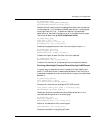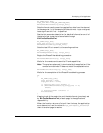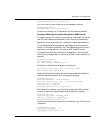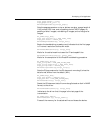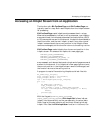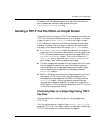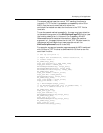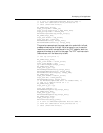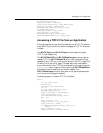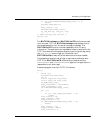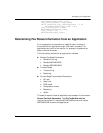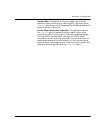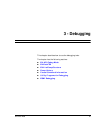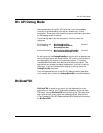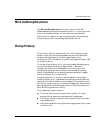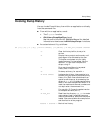
Developing a Fax Application
November 2009 87
BT_ZERO(args_strip);
args_strip.fmt = DATA_G3;
args_strip.resolution = RES_200H_100V;
args_strip.width = WIDTH_A4;
BfvFaxStripParams(lp,&args_strip);
BT_ZERO(args_fax);
args_fax.fname = "g3_file";
args_fax.fmt = DATA_G3;
BfvFaxSendFile(lp, &args_fax);
BfvFaxEndOfDocument(lp, &args_fax);
Accessing a TIFF-F File from an Application
Although applications can directly read and write TIFF-F files with
a set of Bfv library functions, some knowledge of TIFF-F file format
is useful.
The BfvTiffOpen and BfvTiffClose functions open and close
TIFF-F files, respectively.
The BfvTiffReadIFD and BfvTiffReadImage functions read an
opened TIFF file. BfvTiffReadIFD calls a user-supplied function
repeatedly with IFD entry information stored in an IFD (Image File
Directory) for a particular page. The application can use fseek to
move to locations in the TIFF file as directed by the tags (using the
TIFF_FP(tp) macro to get the file pointer) and BfvTiffReadRes to
help determine the resolution, as is often needed. The
BfvTiffReadImage function puts data into a user-supplied buffer
until the end of the page is reached.
A sample program to read a TIFF-F file follows:
main()
{
int my_ifd_func();
TFILE *tp;
unsigned char buf[1024];
int n;
struct args_tiff args_tiff;
BT_ZERO(args_tiff);
args_tiff.fname = "filename";
args_tiff.fmode = "r";
tp = BfvTiffOpen(&args_tiff);
for (;;)
{
args_tiff.tp = tp;
args_tiff.func = my_ifd_func;
args_tiff.arg = NULL;
if (BfvTiffReadIFD(&args_tiff) <= 0)
break;
args_tiff.buf = buf;
args_tiff.size = sizeof(buf);



